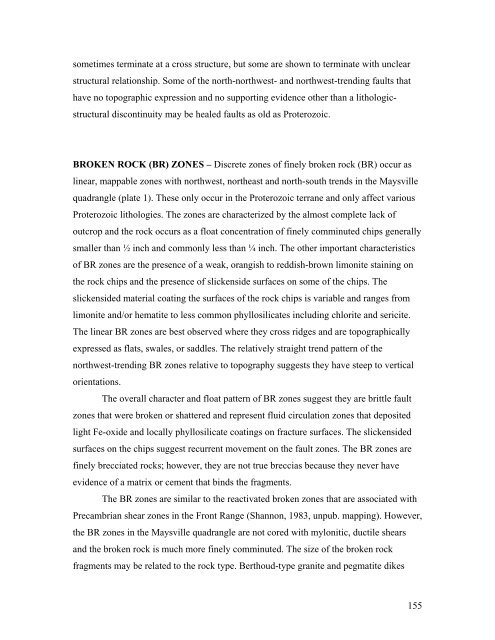Geologic Map of the Maysville Quadrangle, Chaffee County, Colorado
Geologic Map of the Maysville Quadrangle, Chaffee County, Colorado
Geologic Map of the Maysville Quadrangle, Chaffee County, Colorado
You also want an ePaper? Increase the reach of your titles
YUMPU automatically turns print PDFs into web optimized ePapers that Google loves.
sometimes terminate at a cross structure, but some are shown to terminate with unclear<br />
structural relationship. Some <strong>of</strong> <strong>the</strong> north-northwest- and northwest-trending faults that<br />
have no topographic expression and no supporting evidence o<strong>the</strong>r than a lithologicstructural<br />
discontinuity may be healed faults as old as Proterozoic.<br />
BROKEN ROCK (BR) ZONES – Discrete zones <strong>of</strong> finely broken rock (BR) occur as<br />
linear, mappable zones with northwest, nor<strong>the</strong>ast and north-south trends in <strong>the</strong> <strong>Maysville</strong><br />
quadrangle (plate 1). These only occur in <strong>the</strong> Proterozoic terrane and only affect various<br />
Proterozoic lithologies. The zones are characterized by <strong>the</strong> almost complete lack <strong>of</strong><br />
outcrop and <strong>the</strong> rock occurs as a float concentration <strong>of</strong> finely comminuted chips generally<br />
smaller than ½ inch and commonly less than ¼ inch. The o<strong>the</strong>r important characteristics<br />
<strong>of</strong> BR zones are <strong>the</strong> presence <strong>of</strong> a weak, orangish to reddish-brown limonite staining on<br />
<strong>the</strong> rock chips and <strong>the</strong> presence <strong>of</strong> slickenside surfaces on some <strong>of</strong> <strong>the</strong> chips. The<br />
slickensided material coating <strong>the</strong> surfaces <strong>of</strong> <strong>the</strong> rock chips is variable and ranges from<br />
limonite and/or hematite to less common phyllosilicates including chlorite and sericite.<br />
The linear BR zones are best observed where <strong>the</strong>y cross ridges and are topographically<br />
expressed as flats, swales, or saddles. The relatively straight trend pattern <strong>of</strong> <strong>the</strong><br />
northwest-trending BR zones relative to topography suggests <strong>the</strong>y have steep to vertical<br />
orientations.<br />
The overall character and float pattern <strong>of</strong> BR zones suggest <strong>the</strong>y are brittle fault<br />
zones that were broken or shattered and represent fluid circulation zones that deposited<br />
light Fe-oxide and locally phyllosilicate coatings on fracture surfaces. The slickensided<br />
surfaces on <strong>the</strong> chips suggest recurrent movement on <strong>the</strong> fault zones. The BR zones are<br />
finely brecciated rocks; however, <strong>the</strong>y are not true breccias because <strong>the</strong>y never have<br />
evidence <strong>of</strong> a matrix or cement that binds <strong>the</strong> fragments.<br />
The BR zones are similar to <strong>the</strong> reactivated broken zones that are associated with<br />
Precambrian shear zones in <strong>the</strong> Front Range (Shannon, 1983, unpub. mapping). However,<br />
<strong>the</strong> BR zones in <strong>the</strong> <strong>Maysville</strong> quadrangle are not cored with mylonitic, ductile shears<br />
and <strong>the</strong> broken rock is much more finely comminuted. The size <strong>of</strong> <strong>the</strong> broken rock<br />
fragments may be related to <strong>the</strong> rock type. Berthoud-type granite and pegmatite dikes<br />
155




